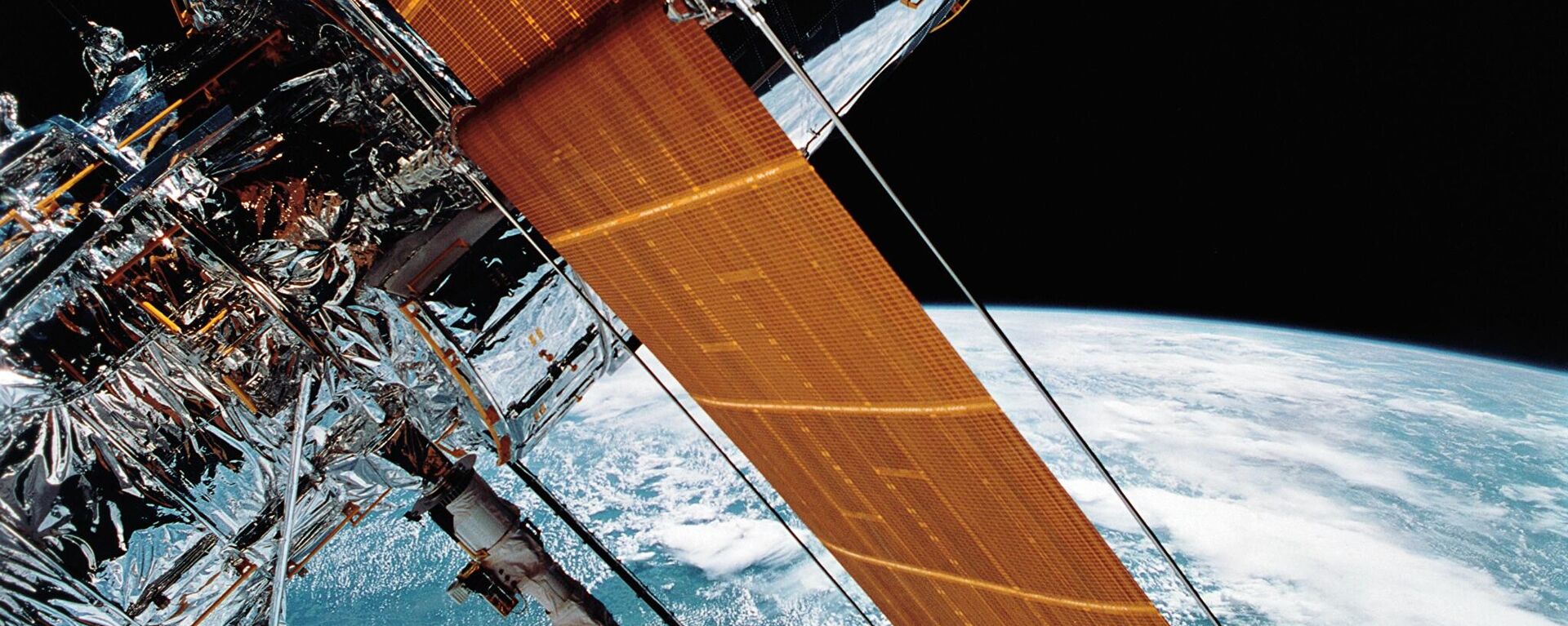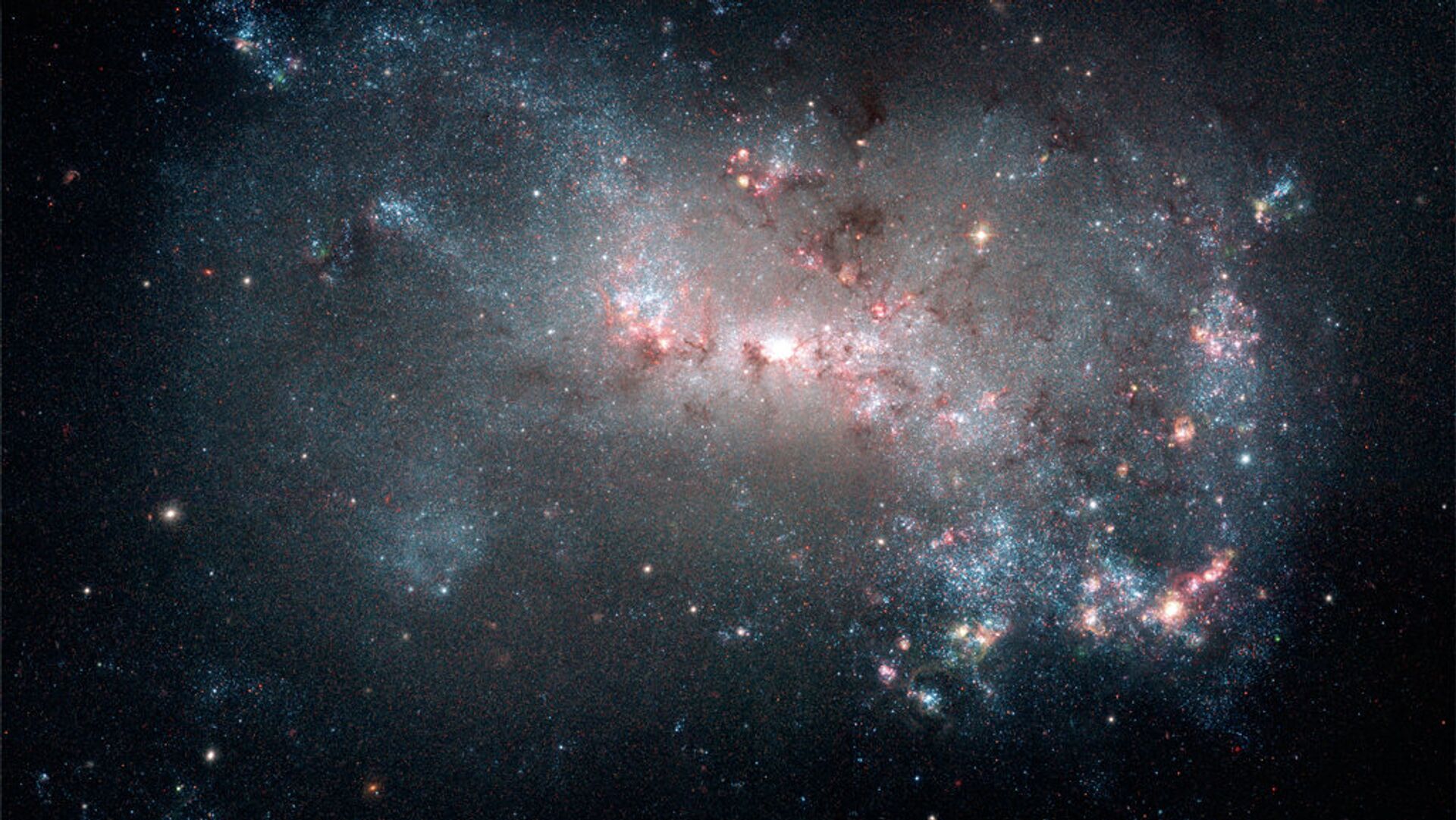https://sputnikglobe.com/20220930/hubble-telescope-uncovers-protective-secrets-of-two-dwarf-galaxies-1101396385.html
Hubble Telescope Uncovers Protective Secrets of Two Dwarf Galaxies
Hubble Telescope Uncovers Protective Secrets of Two Dwarf Galaxies
Sputnik International
Since its launch in 1990, the Hubble Space Telescope has been an invaluable research tool for scientists looking to expand our intergalactic understanding. The... 30.09.2022, Sputnik International
2022-09-30T21:23+0000
2022-09-30T21:23+0000
2023-04-12T16:58+0000
science & tech
hubble space telescope
dwarf galaxy
secret
shield
space
https://cdn1.img.sputnikglobe.com/img/102216/05/1022160563_0:0:1024:577_1920x0_80_0_0_c0b48e32ad3245ddd6679e8023f68e43.jpg
Data recently revealed by the telescope indicates that galactic shields called coronas, which are usually difficult to detect, protect dwarf galaxies from the Milky Way’s gravitational pull.Named after the explorer Ferdinand Magellan, the Large Magellanic Cloud (LMC) and the Small Magellanic Cloud (SMC) are two satellite dwarf galaxies of the Milky Way making up part of what’s known as the Local Group – so named for its proximity to our own Milky Way.Other than their proximity to Earth, the LMC and SMC are known for being sites where stars form, a fact that scientists have been scratching their heads over, because the much more massive Milky Way has been stripping star-forming gas from the two galaxies, leaving a visible trail in their wake.Assistant professor Dhanesh Krisnharao of Colorado College explained the quandary in a NASA-released statement:"A lot of people were struggling to explain how these streams of material could be there. If this gas was removed from these galaxies, how are they still forming stars?"Researchers used spectroscopic observations of ultraviolet light from quasars, which are star-like extragalactic objects that may emit radio waves, to detect and map the protective halo of gas surrounding the Small and Large Magellanic Clouds, which allows the clouds to retain enough star-forming gas.These cocoons, called coronas, have been spotted near other galaxies but never before has one been seen in so much detail, or so close to the Milky Way. According to the team’s reasoning, the corona was likely visible due to the “distorting” effect it has on light from quasars shining beyond it.The team believes galactic coronas like the one shielding the Magellanic Clouds are formed from “primordial clouds of gas that undergo gravitational collapse” to form galaxies. These clouds allow formations like the Magellanic Clouds to continue forming stars."Anything that tries to pass into the galaxy has to pass through this material first, so it can absorb some of that impact," he said. "In addition, the corona is the first material that can be extracted. While giving up a little bit of the corona, you're protecting the gas that's inside the galaxy itself and able to form new stars."The information was published in the September 28 issue of Nature.
https://sputnikglobe.com/20220930/nasa-spacex-launch-feasibility-study-to-give-hubble-telescope-longer-life---officials-1101359472.html
Sputnik International
feedback@sputniknews.com
+74956456601
MIA „Rossiya Segodnya“
2022
News
en_EN
Sputnik International
feedback@sputniknews.com
+74956456601
MIA „Rossiya Segodnya“
Sputnik International
feedback@sputniknews.com
+74956456601
MIA „Rossiya Segodnya“
science & tech, hubble space telescope, dwarf galaxy, secret, shield, space
science & tech, hubble space telescope, dwarf galaxy, secret, shield, space
Hubble Telescope Uncovers Protective Secrets of Two Dwarf Galaxies
21:23 GMT 30.09.2022 (Updated: 16:58 GMT 12.04.2023) Since its launch in 1990, the Hubble Space Telescope has been an invaluable research tool for scientists looking to expand our intergalactic understanding. The telescope is expected to endure until the 2030s.
Data recently revealed by the telescope indicates that galactic shields called coronas, which are usually difficult to detect, protect dwarf galaxies from the Milky Way’s gravitational pull.
Named after the explorer Ferdinand Magellan, the Large Magellanic Cloud (LMC) and the Small Magellanic Cloud (SMC) are two satellite dwarf galaxies of the Milky Way making up part of what’s known as the Local Group – so named for its proximity to our own Milky Way.
Other than their proximity to Earth, the LMC and SMC are known for being sites where stars form, a fact that scientists have been scratching their heads over, because the much more massive Milky Way has been stripping star-forming gas from the two galaxies, leaving a visible trail in their wake. Assistant professor Dhanesh Krisnharao of Colorado College explained the quandary in a NASA-released statement:
"A lot of people were struggling to explain how these streams of material could be there. If this gas was removed from these galaxies, how are they still forming stars?"

30 September 2022, 01:20 GMT
Researchers used spectroscopic
observations of ultraviolet light from quasars, which are star-like extragalactic objects that may emit radio waves, to detect and map the protective halo of gas surrounding the Small and Large Magellanic Clouds, which allows the clouds to retain enough star-forming gas.
"Galaxies enveloped themselves in gaseous cocoons, which act as defensive shields against other galaxies," Andrew Fox, an astronomer with the
Space Telescope Science Institute in Maryland who participated in the study, said in the statement.
These cocoons, called coronas, have been spotted near other galaxies but never before has one been seen in so much detail, or so close to the Milky Way. According to the team’s reasoning, the corona was likely visible due to the “distorting” effect it has on light from quasars shining beyond it.
"There're lots of predictions from computer simulations about what they should look like, how they should interact over billions of years," said Krishnarao. "Observationally we can't really test most of them because dwarf galaxies are typically just too hard to detect."
The team believes galactic coronas like the one shielding the Magellanic Clouds are formed from “primordial clouds of gas that undergo gravitational collapse” to form galaxies. These clouds allow formations like the Magellanic Clouds to continue forming stars.
"Anything that tries to pass into the galaxy has to pass through this material first, so it can absorb some of that impact," he said. "In addition, the corona is the first material that can be extracted. While giving up a little bit of the corona, you're protecting the gas that's inside the galaxy itself and able to form new stars."
The information was published in the September 28 issue of
Nature.

